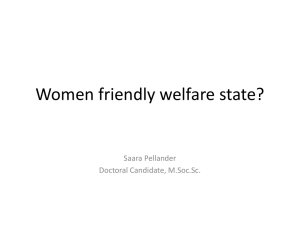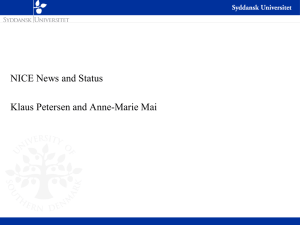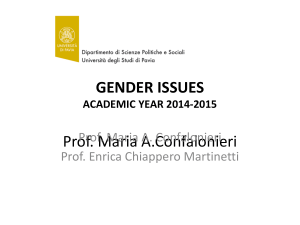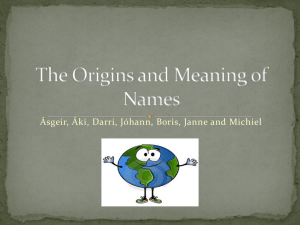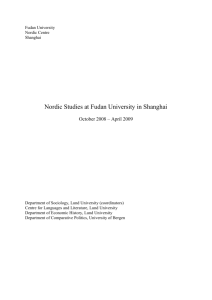The Nordic model
advertisement
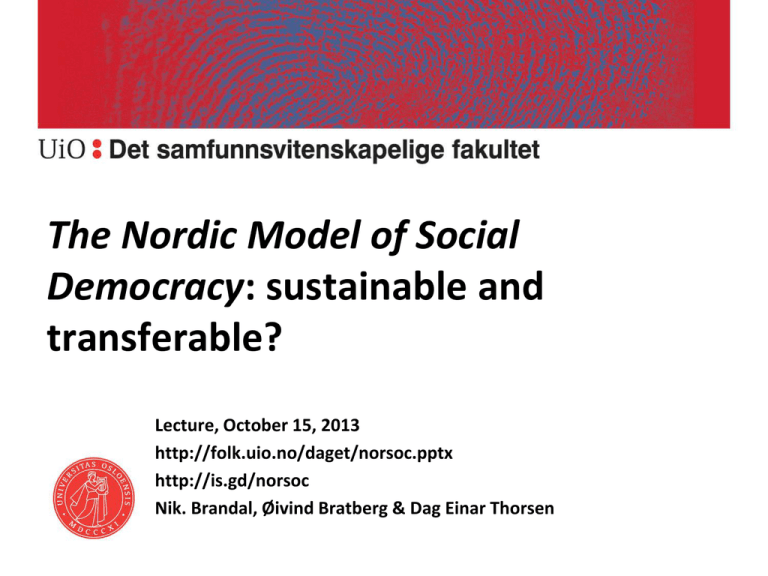
The Nordic Model of Social Democracy: sustainable and transferable? Lecture, October 15, 2013 http://folk.uio.no/daget/norsoc.pptx http://is.gd/norsoc Nik. Brandal, Øivind Bratberg & Dag Einar Thorsen Outline of the book Preface 1. Introduction PART I: ORIGINS 2. The Birth of the Social Democratic Movement (1848–1916) 3. Towards a Nordic Model (1916–1940) 4. Planning the Welfare State (1940–1970) PART II: SOCIAL DEMOCRACY AND THE NORDIC MODEL 5. The Nordic Model in a Global Economy 6. The Welfare State: The Good Life or Dependency? 7. A Better and More Organized World PART III: IS THE NORDIC MODEL SUSTAINABLE? 8. Economic Growth and Environmental Protection 9. The Sustainability of the Welfare State 10. Liberty, Empowerment, and Community PART IV: CONCLUSION 11. Concluding Essay: The Power of Politics The Nordic model (as commonly understood) • Strong trade unions; coordination and compromise between the social partners through centralised negotiations over wages and work conditions. • A comprehensive welfare state dominated by universal entitlements. • Activist industrial policy. • Also: high participation in the labour market, small wage differences, gender equality etc. Productivity and collective effort • High participation in the labour market ensure revenue for the state and limited benefits costs. • Corporate profit geared towards reinvestment through incentives in the taxation system. • Small wage differentials enourage high-skilled and competitive enterprise; enterprise unable to compete is allowed to wither away. • Thus: private and public sector are mutually dependent. kindergartens! Public transport! Effective administration! High levels of social and geographical mobility. Security as encouragement, not roadblock for entrepreneurship People who feel secure dare to start an enterprise… That is what creates business and employment... Because we are good at sharing, we excel in creating as well. And because we are good at creating, there is ever more to share. This is social democracy in practice! This is the Norwegian model. - Jens Stoltenberg, Prime Minister of Norway 2005- Freedom is the essential goal The main task of socialism today is to prevent the concentration of power in the hands of either industrial management or the state bureaucracy – in brief, to distribute responsibility and so to enlarge the freedom of choice. – Richard Crossman, 1952 Requirements and the sustainability issue • Fight for equality should not equal a fight for conformity – equal opportunities, individual freedom (social and cultural obstacles to human growth). The welfare state is an emancipation project! • It is an open question to what extent and under what circumstances the welfare state can be conducive to equality defined in these terms. • Peculiar combination of equality, self-help, and community has provided the ideological foundations of the Nordic model Requirements and the sustainability issue (2) • Individual liberty through state regulation – a paradox? • Maternalistic view that everyone is obliged to contribute to collective welfare provisions, and that no one is allowed to put their own lives and well-being at risk. • The argument against means-testing…does it work today? • The case against basic income… does it work today? Sustainability: the more specific problems • Sweden: social services (unemployment benefit in particular) closely linked to trade union strength. • Norway: larger share of statutory rights. • Particular problem in Norway: ever-increasing expectations. • Shared by all three countries: challenges of sustaining high employment and high productivity to finance public welfare. Sustainability (2) • Threats to the sustainability of the Nordic model relate to a range of areas – among them: - Financial sustainability: can future welfare be funded, in light of economic and demographic change? Will the Nordic states remain sufficiently productive? - Moral sustainability: in a society characterised by greater diversity – ethnic and social – can a sufficient level of cohesion be maintained? Community feeling and moral sustainability • Social democracy grounded in vision of ever-expanding community (from partial interests to society as a whole). • Can community be sustained (and further expanded) today? • Globalisation and new class divisions, but also individualism, consumerism. • Rise and fall of the twentieth-century welfare state – or renewal? Exceptional… and social democratic? • The argument of Nordic exceptionalism can easily be overstated. • Collective effort has been aided by cultural preconditions, but also cultivated by lengthy periods of social democratic government. • Historically: profound social conflict overcome; political settlements in the 1930s helped the country onto a pacific and productive track. • An important part of the equation: cross-class ideas embedded in politics and institutions. Only Nordic? Or transferable? • The Norwegian case has been aided by national and social cohesion… • …but the quintessential element: institutions for collective decision making + continuous mobilisation from below • Welfare state as «institutionalised solidarity» • Requires ability to create as well as willingness to share How strong? • How strong is the Nordic Model today? • What have been the consequences of prolonged centreright governments in Sweden and Denmark? • What will the consequences of the new conservative/libertarian government in Norway be? • «The good home does not know any privileged nor neglected. No one benefits from advantages over the others, the strong does not frown upon or exploit the weak. In the good home, equality, compassion and cooperation reign. Applied on the greater people’s or citizens’ home this should mean the removal of all social and economic barriers now dividing privileged from neglected, rulers from ruled, exploiters from the exploited.» Per Albin Hansson, Prime Minister of Sweden 1932-1946.
